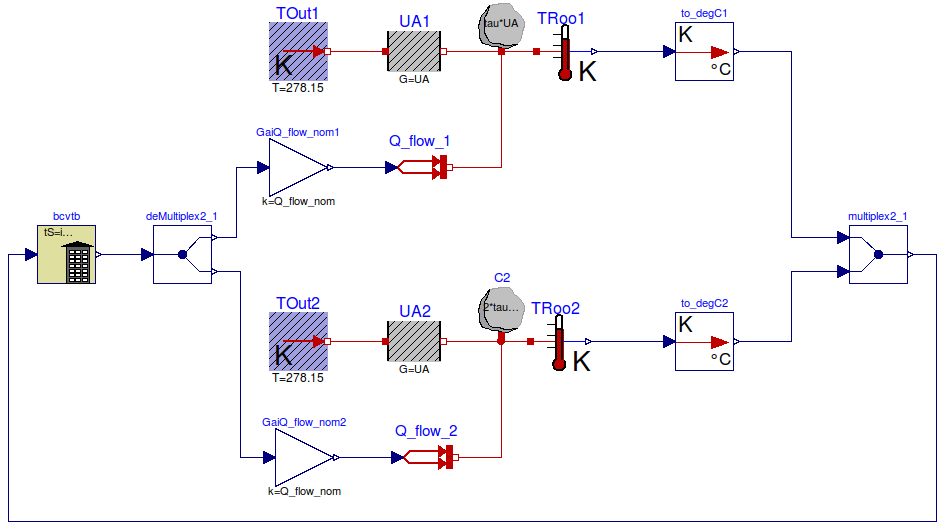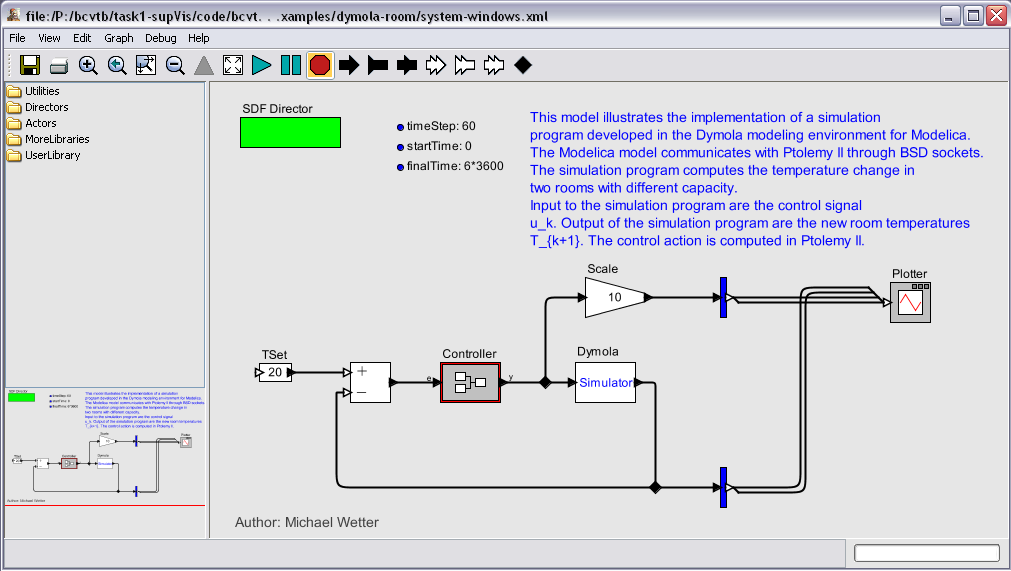| 4.4. Dymola | ||
|---|---|---|
 | Chapter 4. Configuring programs for use with the BCVTB |  |
To configure a Modelica model that will be simulated by
Dymola, you may modify the files in the directory
BCVTB/examples/dymola-room, or you may
create a new Modelica model. This section describes how
to create a new Modelica model using the Dymola modeling
and simulation environment. The configuration consists of
creating a Modelica model, a Modelica script and a
Ptolemy II model.
To create a new Modelica model, proceed as follows:
First, open Dymola and the Buildings library, which may
be downloaded from
http://simulationresearch.lbl.gov/modelica
. From the Buildings library, add the block
Buildings.Utilities.IO.BCVTB.BCVTB
to your model. Next, connect the bcvtb
block to your other Modelica models to create a system
model that takes signals from the bcvtb
block and writes signals to the bcvtb
block. This may yield a system model as shown in
Figure 4.9
, which is the model in the file
bcvtb/examples/dymola-room/TwoRoomsTotal.mo.
Figure 4.9. Graphical view of the Modelica model that computes the change in temperature for two simple room models.

To configure the bcvtb interface,
double-click on the bcvtb block that is
shown in the left of the figure. This will open the
input form shown in
Figure 4.10
.
In this example, a vector with two double values are obtained from the BCVTB and written to the BCVTB every 60 seconds of simulation time. Additional information about this block can be obtained by pressing the button.
To perform a simulation, the BCVTB will call a batch
file (on Windows) or a shell script (on Linux), which in
turn calls Dymola to execute a Modelica script that
opens and simulates the model. The batch file or shell
script is stored in the directory bcvtb/bin
and need not be changed by the user. To create the
Modelica script, adjust the following three lines as
needed and save them in a file called
simulateAndExit.mos:
openModel("TwoRoomsTotal.mo");
simulateModel("Buildings_Utilities_IO_BCVTB_Examples_TwoRooms", stopTime=21600);
exit();
To start Dymola from Ptolemy II, a Ptolemy II model will
need to be created. The model
BCVTB/examples/dymola-room/system-windows.xml
shown in
Figure 4.11
may be used as a starting point.
Figure 4.11.
Ptolemy II system model that links a model of a controller with the Simulator actor that communicates with the Modelica modeling and simulation environment Dymola.

In this model, the Simulator actor that
calls Dymola is configured as shown in
Figure 4.12
.
The batch file runDymola.bat (on Windows)
or the shell script runDymola.sh (on Linux)
will copy the binary and header files that are required
by Dymola. If either dymosim.exe (or
dymosim on Linux) or dsin.txt
do not exist in the current directory, then the batch
file starts Dymola, translates and simulates the model.
Otherwise, the batch file will call dymosim
-s to simulate the model.